NUR3503: Community Vaccination Pamphlet for Hesitant Parents
VerifiedAdded on 2022/08/14
|5
|1191
|17
Practical Assignment
AI Summary
This assignment is a practical pamphlet designed for parents of preschool and school-aged children (0-16 years) who are hesitant about vaccination. The pamphlet, developed in response to increased vaccine hesitancy in the community, aims to educate and support parents by providing a brief explanation of vaccination and its historical context, discussing common myths surrounding vaccination, and presenting evidence-based facts to counter these myths. It outlines the benefits of vaccination and offers guidance on how parents can ensure their children's vaccinations are up-to-date. The pamphlet includes references to support the information provided and direct parents to appropriate resources, such as their local GP, WA Ngala, and the Continence Foundation of Australia. This resource is designed to correct misinformation and encourage parents to make informed decisions about their children's health, ultimately promoting higher vaccination rates within the community.
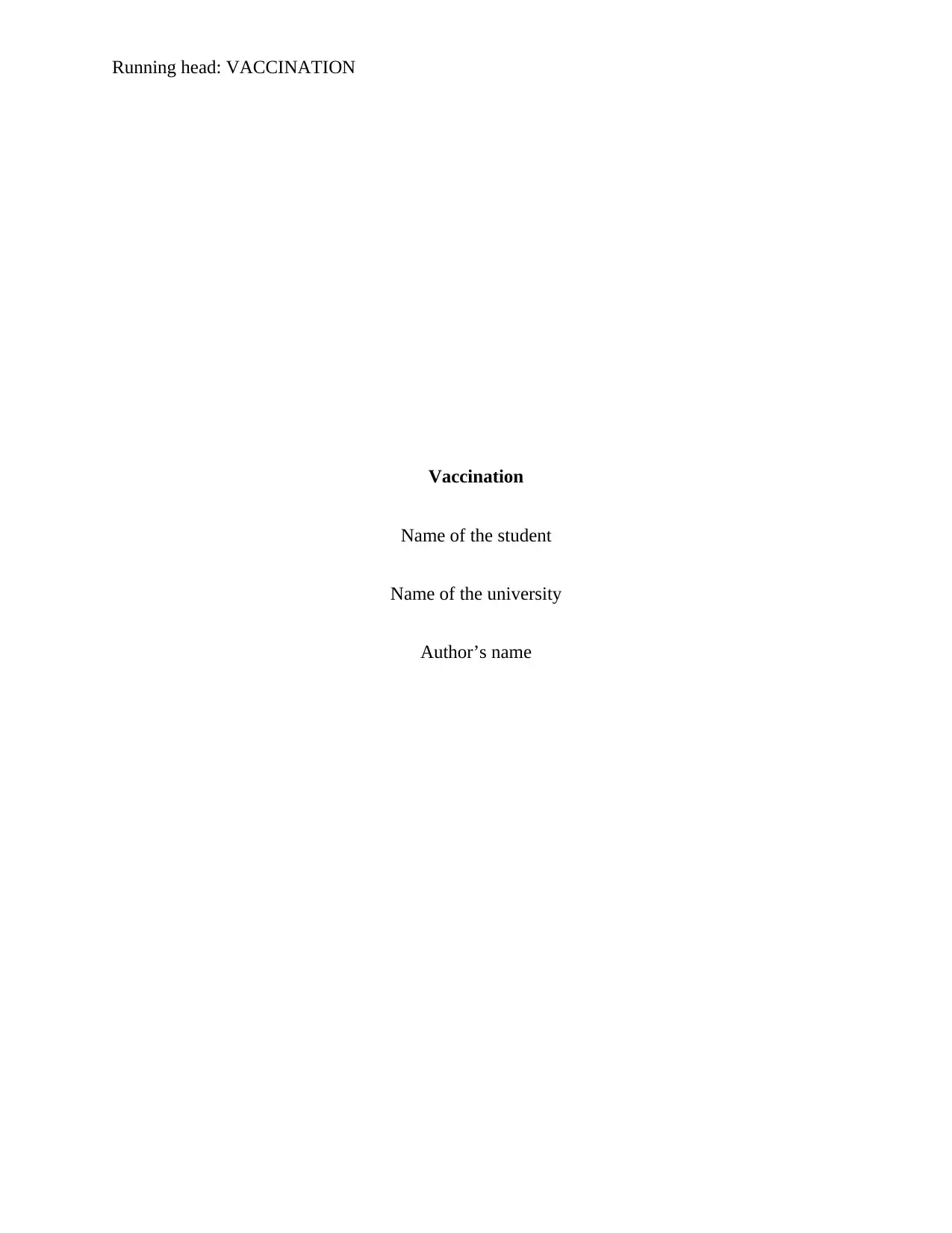
Running head: VACCINATION
Vaccination
Name of the student
Name of the university
Author’s name
Vaccination
Name of the student
Name of the university
Author’s name
Paraphrase This Document
Need a fresh take? Get an instant paraphrase of this document with our AI Paraphraser
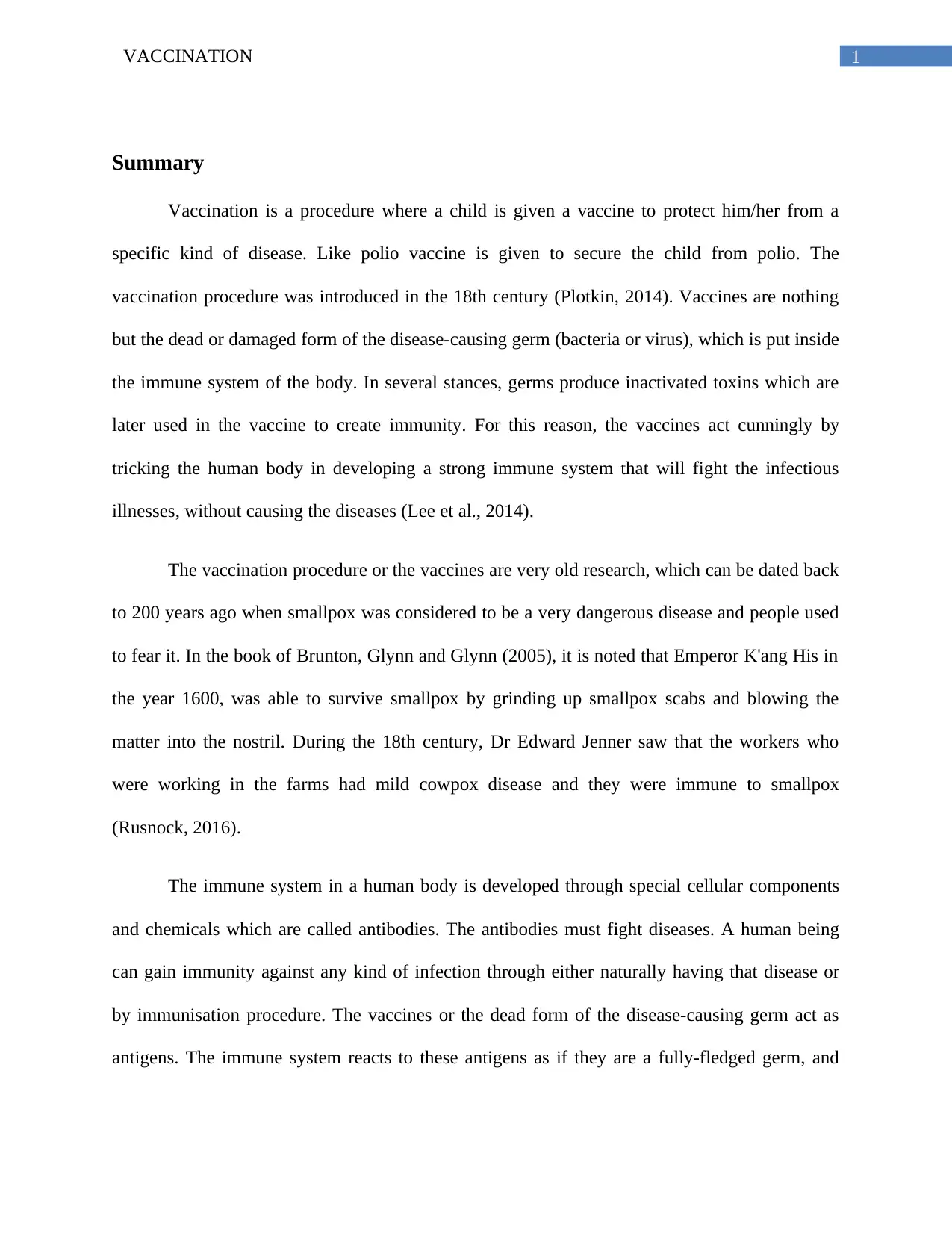
1VACCINATION
Summary
Vaccination is a procedure where a child is given a vaccine to protect him/her from a
specific kind of disease. Like polio vaccine is given to secure the child from polio. The
vaccination procedure was introduced in the 18th century (Plotkin, 2014). Vaccines are nothing
but the dead or damaged form of the disease-causing germ (bacteria or virus), which is put inside
the immune system of the body. In several stances, germs produce inactivated toxins which are
later used in the vaccine to create immunity. For this reason, the vaccines act cunningly by
tricking the human body in developing a strong immune system that will fight the infectious
illnesses, without causing the diseases (Lee et al., 2014).
The vaccination procedure or the vaccines are very old research, which can be dated back
to 200 years ago when smallpox was considered to be a very dangerous disease and people used
to fear it. In the book of Brunton, Glynn and Glynn (2005), it is noted that Emperor K'ang His in
the year 1600, was able to survive smallpox by grinding up smallpox scabs and blowing the
matter into the nostril. During the 18th century, Dr Edward Jenner saw that the workers who
were working in the farms had mild cowpox disease and they were immune to smallpox
(Rusnock, 2016).
The immune system in a human body is developed through special cellular components
and chemicals which are called antibodies. The antibodies must fight diseases. A human being
can gain immunity against any kind of infection through either naturally having that disease or
by immunisation procedure. The vaccines or the dead form of the disease-causing germ act as
antigens. The immune system reacts to these antigens as if they are a fully-fledged germ, and
Summary
Vaccination is a procedure where a child is given a vaccine to protect him/her from a
specific kind of disease. Like polio vaccine is given to secure the child from polio. The
vaccination procedure was introduced in the 18th century (Plotkin, 2014). Vaccines are nothing
but the dead or damaged form of the disease-causing germ (bacteria or virus), which is put inside
the immune system of the body. In several stances, germs produce inactivated toxins which are
later used in the vaccine to create immunity. For this reason, the vaccines act cunningly by
tricking the human body in developing a strong immune system that will fight the infectious
illnesses, without causing the diseases (Lee et al., 2014).
The vaccination procedure or the vaccines are very old research, which can be dated back
to 200 years ago when smallpox was considered to be a very dangerous disease and people used
to fear it. In the book of Brunton, Glynn and Glynn (2005), it is noted that Emperor K'ang His in
the year 1600, was able to survive smallpox by grinding up smallpox scabs and blowing the
matter into the nostril. During the 18th century, Dr Edward Jenner saw that the workers who
were working in the farms had mild cowpox disease and they were immune to smallpox
(Rusnock, 2016).
The immune system in a human body is developed through special cellular components
and chemicals which are called antibodies. The antibodies must fight diseases. A human being
can gain immunity against any kind of infection through either naturally having that disease or
by immunisation procedure. The vaccines or the dead form of the disease-causing germ act as
antigens. The immune system reacts to these antigens as if they are a fully-fledged germ, and
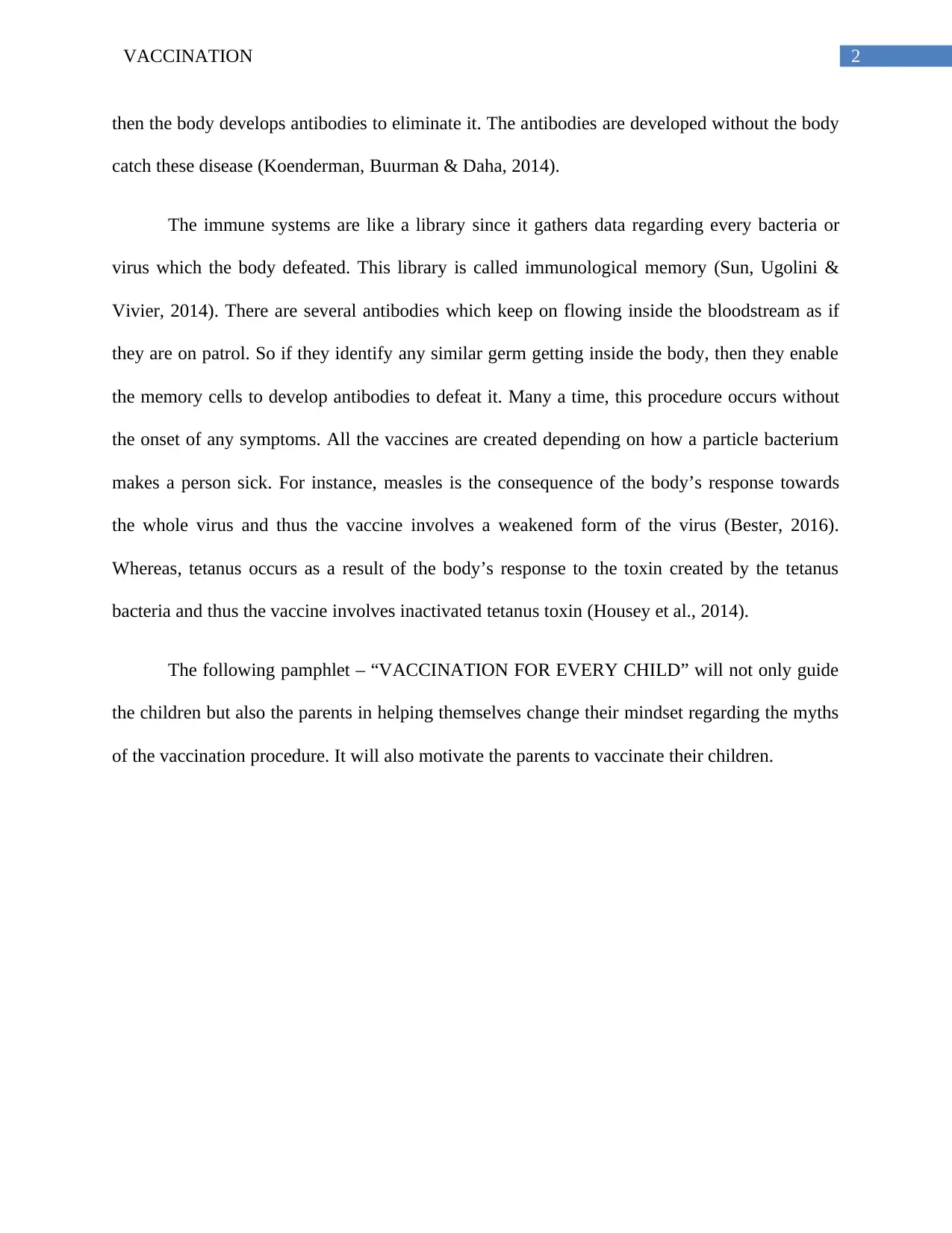
2VACCINATION
then the body develops antibodies to eliminate it. The antibodies are developed without the body
catch these disease (Koenderman, Buurman & Daha, 2014).
The immune systems are like a library since it gathers data regarding every bacteria or
virus which the body defeated. This library is called immunological memory (Sun, Ugolini &
Vivier, 2014). There are several antibodies which keep on flowing inside the bloodstream as if
they are on patrol. So if they identify any similar germ getting inside the body, then they enable
the memory cells to develop antibodies to defeat it. Many a time, this procedure occurs without
the onset of any symptoms. All the vaccines are created depending on how a particle bacterium
makes a person sick. For instance, measles is the consequence of the body’s response towards
the whole virus and thus the vaccine involves a weakened form of the virus (Bester, 2016).
Whereas, tetanus occurs as a result of the body’s response to the toxin created by the tetanus
bacteria and thus the vaccine involves inactivated tetanus toxin (Housey et al., 2014).
The following pamphlet – “VACCINATION FOR EVERY CHILD” will not only guide
the children but also the parents in helping themselves change their mindset regarding the myths
of the vaccination procedure. It will also motivate the parents to vaccinate their children.
then the body develops antibodies to eliminate it. The antibodies are developed without the body
catch these disease (Koenderman, Buurman & Daha, 2014).
The immune systems are like a library since it gathers data regarding every bacteria or
virus which the body defeated. This library is called immunological memory (Sun, Ugolini &
Vivier, 2014). There are several antibodies which keep on flowing inside the bloodstream as if
they are on patrol. So if they identify any similar germ getting inside the body, then they enable
the memory cells to develop antibodies to defeat it. Many a time, this procedure occurs without
the onset of any symptoms. All the vaccines are created depending on how a particle bacterium
makes a person sick. For instance, measles is the consequence of the body’s response towards
the whole virus and thus the vaccine involves a weakened form of the virus (Bester, 2016).
Whereas, tetanus occurs as a result of the body’s response to the toxin created by the tetanus
bacteria and thus the vaccine involves inactivated tetanus toxin (Housey et al., 2014).
The following pamphlet – “VACCINATION FOR EVERY CHILD” will not only guide
the children but also the parents in helping themselves change their mindset regarding the myths
of the vaccination procedure. It will also motivate the parents to vaccinate their children.
⊘ This is a preview!⊘
Do you want full access?
Subscribe today to unlock all pages.

Trusted by 1+ million students worldwide
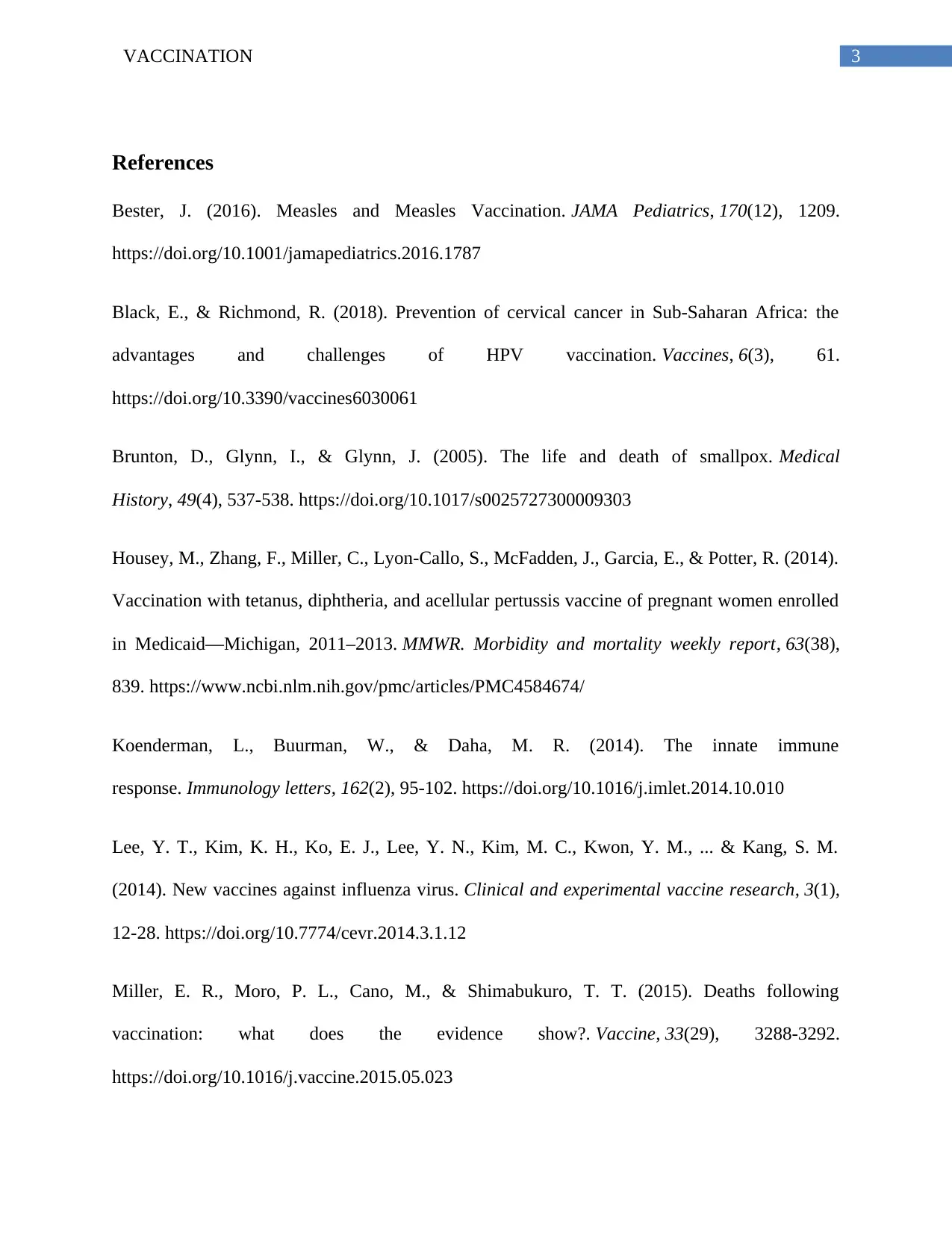
3VACCINATION
References
Bester, J. (2016). Measles and Measles Vaccination. JAMA Pediatrics, 170(12), 1209.
https://doi.org/10.1001/jamapediatrics.2016.1787
Black, E., & Richmond, R. (2018). Prevention of cervical cancer in Sub-Saharan Africa: the
advantages and challenges of HPV vaccination. Vaccines, 6(3), 61.
https://doi.org/10.3390/vaccines6030061
Brunton, D., Glynn, I., & Glynn, J. (2005). The life and death of smallpox. Medical
History, 49(4), 537-538. https://doi.org/10.1017/s0025727300009303
Housey, M., Zhang, F., Miller, C., Lyon-Callo, S., McFadden, J., Garcia, E., & Potter, R. (2014).
Vaccination with tetanus, diphtheria, and acellular pertussis vaccine of pregnant women enrolled
in Medicaid—Michigan, 2011–2013. MMWR. Morbidity and mortality weekly report, 63(38),
839. https://www.ncbi.nlm.nih.gov/pmc/articles/PMC4584674/
Koenderman, L., Buurman, W., & Daha, M. R. (2014). The innate immune
response. Immunology letters, 162(2), 95-102. https://doi.org/10.1016/j.imlet.2014.10.010
Lee, Y. T., Kim, K. H., Ko, E. J., Lee, Y. N., Kim, M. C., Kwon, Y. M., ... & Kang, S. M.
(2014). New vaccines against influenza virus. Clinical and experimental vaccine research, 3(1),
12-28. https://doi.org/10.7774/cevr.2014.3.1.12
Miller, E. R., Moro, P. L., Cano, M., & Shimabukuro, T. T. (2015). Deaths following
vaccination: what does the evidence show?. Vaccine, 33(29), 3288-3292.
https://doi.org/10.1016/j.vaccine.2015.05.023
References
Bester, J. (2016). Measles and Measles Vaccination. JAMA Pediatrics, 170(12), 1209.
https://doi.org/10.1001/jamapediatrics.2016.1787
Black, E., & Richmond, R. (2018). Prevention of cervical cancer in Sub-Saharan Africa: the
advantages and challenges of HPV vaccination. Vaccines, 6(3), 61.
https://doi.org/10.3390/vaccines6030061
Brunton, D., Glynn, I., & Glynn, J. (2005). The life and death of smallpox. Medical
History, 49(4), 537-538. https://doi.org/10.1017/s0025727300009303
Housey, M., Zhang, F., Miller, C., Lyon-Callo, S., McFadden, J., Garcia, E., & Potter, R. (2014).
Vaccination with tetanus, diphtheria, and acellular pertussis vaccine of pregnant women enrolled
in Medicaid—Michigan, 2011–2013. MMWR. Morbidity and mortality weekly report, 63(38),
839. https://www.ncbi.nlm.nih.gov/pmc/articles/PMC4584674/
Koenderman, L., Buurman, W., & Daha, M. R. (2014). The innate immune
response. Immunology letters, 162(2), 95-102. https://doi.org/10.1016/j.imlet.2014.10.010
Lee, Y. T., Kim, K. H., Ko, E. J., Lee, Y. N., Kim, M. C., Kwon, Y. M., ... & Kang, S. M.
(2014). New vaccines against influenza virus. Clinical and experimental vaccine research, 3(1),
12-28. https://doi.org/10.7774/cevr.2014.3.1.12
Miller, E. R., Moro, P. L., Cano, M., & Shimabukuro, T. T. (2015). Deaths following
vaccination: what does the evidence show?. Vaccine, 33(29), 3288-3292.
https://doi.org/10.1016/j.vaccine.2015.05.023
Paraphrase This Document
Need a fresh take? Get an instant paraphrase of this document with our AI Paraphraser
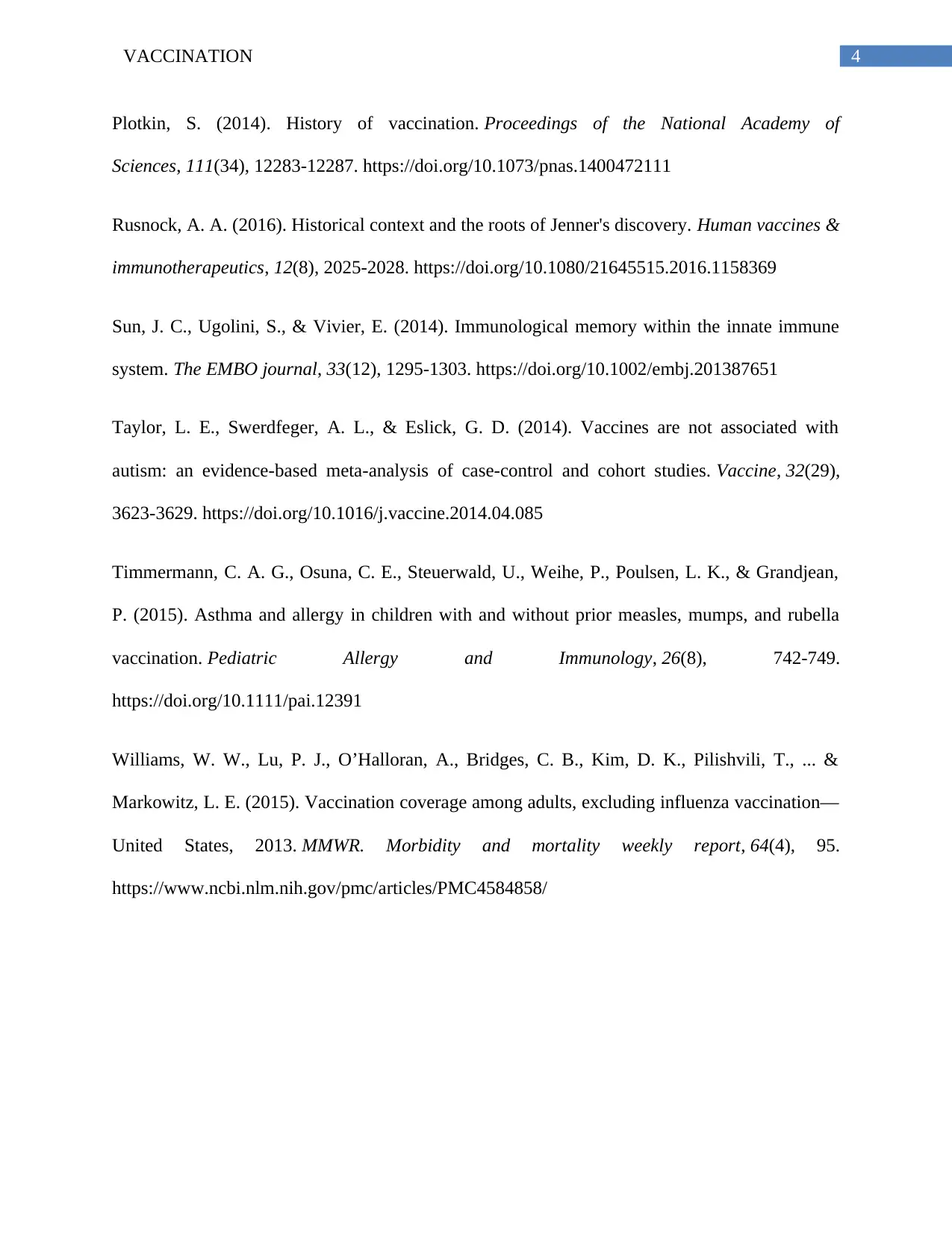
4VACCINATION
Plotkin, S. (2014). History of vaccination. Proceedings of the National Academy of
Sciences, 111(34), 12283-12287. https://doi.org/10.1073/pnas.1400472111
Rusnock, A. A. (2016). Historical context and the roots of Jenner's discovery. Human vaccines &
immunotherapeutics, 12(8), 2025-2028. https://doi.org/10.1080/21645515.2016.1158369
Sun, J. C., Ugolini, S., & Vivier, E. (2014). Immunological memory within the innate immune
system. The EMBO journal, 33(12), 1295-1303. https://doi.org/10.1002/embj.201387651
Taylor, L. E., Swerdfeger, A. L., & Eslick, G. D. (2014). Vaccines are not associated with
autism: an evidence-based meta-analysis of case-control and cohort studies. Vaccine, 32(29),
3623-3629. https://doi.org/10.1016/j.vaccine.2014.04.085
Timmermann, C. A. G., Osuna, C. E., Steuerwald, U., Weihe, P., Poulsen, L. K., & Grandjean,
P. (2015). Asthma and allergy in children with and without prior measles, mumps, and rubella
vaccination. Pediatric Allergy and Immunology, 26(8), 742-749.
https://doi.org/10.1111/pai.12391
Williams, W. W., Lu, P. J., O’Halloran, A., Bridges, C. B., Kim, D. K., Pilishvili, T., ... &
Markowitz, L. E. (2015). Vaccination coverage among adults, excluding influenza vaccination—
United States, 2013. MMWR. Morbidity and mortality weekly report, 64(4), 95.
https://www.ncbi.nlm.nih.gov/pmc/articles/PMC4584858/
Plotkin, S. (2014). History of vaccination. Proceedings of the National Academy of
Sciences, 111(34), 12283-12287. https://doi.org/10.1073/pnas.1400472111
Rusnock, A. A. (2016). Historical context and the roots of Jenner's discovery. Human vaccines &
immunotherapeutics, 12(8), 2025-2028. https://doi.org/10.1080/21645515.2016.1158369
Sun, J. C., Ugolini, S., & Vivier, E. (2014). Immunological memory within the innate immune
system. The EMBO journal, 33(12), 1295-1303. https://doi.org/10.1002/embj.201387651
Taylor, L. E., Swerdfeger, A. L., & Eslick, G. D. (2014). Vaccines are not associated with
autism: an evidence-based meta-analysis of case-control and cohort studies. Vaccine, 32(29),
3623-3629. https://doi.org/10.1016/j.vaccine.2014.04.085
Timmermann, C. A. G., Osuna, C. E., Steuerwald, U., Weihe, P., Poulsen, L. K., & Grandjean,
P. (2015). Asthma and allergy in children with and without prior measles, mumps, and rubella
vaccination. Pediatric Allergy and Immunology, 26(8), 742-749.
https://doi.org/10.1111/pai.12391
Williams, W. W., Lu, P. J., O’Halloran, A., Bridges, C. B., Kim, D. K., Pilishvili, T., ... &
Markowitz, L. E. (2015). Vaccination coverage among adults, excluding influenza vaccination—
United States, 2013. MMWR. Morbidity and mortality weekly report, 64(4), 95.
https://www.ncbi.nlm.nih.gov/pmc/articles/PMC4584858/
1 out of 5
Related Documents
Your All-in-One AI-Powered Toolkit for Academic Success.
+13062052269
info@desklib.com
Available 24*7 on WhatsApp / Email
![[object Object]](/_next/static/media/star-bottom.7253800d.svg)
Unlock your academic potential
Copyright © 2020–2025 A2Z Services. All Rights Reserved. Developed and managed by ZUCOL.





